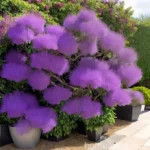Smoketree (Cotinus coggygria ‘Daydream’): A Beautiful and Unique Ornamental Plant
As a plant scientist and enthusiast, I am thrilled to dive into the enchanting world of the smoketree (Cotinus coggygria ‘Daydream’). This distinctive plant, with its unique foliage and striking flowers, has captured the hearts of many gardeners and landscapers. In this comprehensive guide, we will explore the various aspects of the smoketree, including its culture, uses, care requirements, propagation, common diseases and pests, as well as fun facts and botanist’s tips. Whether you are already a smoketree aficionado or are just beginning to discover its allure, this article is designed to provide valuable insights into the captivating world of the smoketree.
What is the Smoketree (Cotinus coggygria ‘Daydream’)?
The smoketree, scientifically known as Cotinus coggygria ‘Daydream’, is a deciduous shrub or small tree that belongs to the Anacardiaceae family. This plant is renowned for its ethereal, smoke-like plumes of flowers that grace its branches during the flowering season. The ‘Daydream’ cultivar, in particular, is celebrated for its vibrant and multi-colored foliage, adding an extra dimension of visual interest to any landscape.
Key Takeaways – Smoketree (Cotinus coggygria ‘Daydream’)
Before we embark on our exploration of the smoketree, let’s take a moment to highlight the key takeaways about this captivating plant:
- Botanical Name: Cotinus coggygria ‘Daydream’
- Plant Type: Deciduous shrub or small tree
- Family: Anacardiaceae
- Notable Feature: Ethereal, smoke-like plumes of flowers
- Distinctive Attribute: Multi-colored foliage
- Cultivar: ‘Daydream’
Now that we have outlined the core characteristics of the smoketree, let’s delve into the various aspects of its culture, uses, and care guidelines.
Culture
Understanding the cultural requirements of the smoketree is essential for creating an environment where it can thrive. Whether you are considering adding it to your garden or maintaining an existing specimen, optimizing its cultural conditions will contribute to its overall health and vibrancy.
Water
The smoketree, once established, demonstrates good tolerance to drought conditions. However, during the initial phases of growth and establishment, it benefits from regular watering to facilitate root development and overall vigor. Deep, infrequent watering is recommended, particularly during dry spells, to encourage healthy root growth and reduce the risk of waterlogging.
Sunlight
When it comes to sunlight requirements, the smoketree truly shines. This plant thrives in full sun to partial shade, making it a versatile addition to various garden settings. In regions with scorching summers, providing some afternoon shade can be beneficial, as it helps protect the foliage from potential sun damage.
Fertilizer
For optimal growth and flowering, the smoketree can benefit from a balanced, slow-release fertilizer in early spring, just before new growth emerges. Avoid over-fertilization, as this can lead to excessive foliage at the expense of flower production. A general-purpose fertilizer with a balanced NPK ratio is suitable for the smoketree.
Soil
The smoketree is adaptable to a range of soil types, provided they are well-draining. It can thrive in loamy, sandy, or clay soils, as long as they do not become waterlogged. Prioritize soil with good drainage to prevent water-related issues and encourage healthy root development.
Uses
The smoketree (Cotinus coggygria ‘Daydream’) offers a myriad of uses, from its ornamental appeal in landscaping to its potential medicinal properties. Let’s explore the diverse applications of this captivating plant.
-
Landscaping: The smoketree is highly valued for its ornamental qualities, making it a prized addition to garden beds, borders, and mixed shrub borders. Its vibrant foliage and unique flowers lend a touch of elegance and drama to any landscape design.
-
Medicinal Purposes: While primarily cultivated for its ornamental value, some traditional herbal remedies incorporate parts of the smoketree for purported health benefits. However, it is essential to consult with a healthcare professional before using any plant for medicinal purposes.
-
Wildlife Habitat: The smoketree can attract pollinators such as bees and butterflies, enriching the biodiversity of the garden and supporting local ecosystems.
Pruning
Proper pruning is essential for maintaining the health and aesthetic appeal of the smoketree. Here are some key considerations for pruning this ornamental plant:
-
Timing: Pruning is best carried out during late winter or early spring when the plant is dormant, before new growth begins.
-
Objective: Focus on removing dead, damaged, or crossing branches to promote air circulation and overall plant health. Additionally, shaping the plant to the desired form can be achieved through selective pruning.
-
Technique: Use clean, sharp pruning tools to make precise cuts, minimizing the risk of damage or disease transmission. For rejuvenating older specimens, consider gradual renewal pruning over several seasons to maintain the plant’s vigor and appearance.
Propagation
Propagation of the smoketree can be achieved through various methods, including:
-
Softwood Cuttings: Gather softwood cuttings in early summer, ensuring they have a heel, and root them in a well-draining medium under controlled humidity and light conditions.
-
Seeds: While viable seeds can be collected from the smoketree, keep in mind that they may not retain the exact characteristics of the parent plant, especially for cultivars like ‘Daydream’.
Container Popularity
Given its moderate size and ornamental appeal, the smoketree can thrive in containers, adding a touch of elegance to patios, balconies, and small outdoor spaces. Select a well-draining potting mix and ensure adequate watering and sunlight to support the plant’s container growth.
Common Diseases
Despite being relatively resilient, the smoketree can fall victim to a few common diseases. It is crucial to be vigilant and address any signs of disease promptly to prevent spread and protect the plant’s health.
-
Powdery Mildew: This fungal disease can affect the foliage of the smoketree, leading to a powdery white coating on the leaves. Adequate air circulation and avoiding overhead watering can help prevent this condition.
-
Leaf Spot: Fungal leaf spot diseases can cause dark or discolored spots on the foliage. Removing and disposing of affected leaves, as well as promoting good sanitation practices, can aid in disease control.
Disease Diagnosis
Diagnosing and addressing potential diseases in the smoketree involves careful observation of symptoms and proactive management strategies. If you notice any unusual changes in the plant’s health or appearance, consider the following steps:
-
Symptom Identification: Pay attention to any spots, discoloration, or abnormal growth patterns on the foliage or stems.
-
Seeking Expert Advice: Enlist the help of a local horticulturist or plant health specialist to accurately diagnose any potential diseases and determine the most appropriate course of action.
-
Cultural Practices: Implementing proper cultural practices, such as adequate spacing between plants, promoting good air circulation, and providing optimal growing conditions, can go a long way in preventing disease outbreaks.
Common Pests
While the smoketree is relatively resistant to pests, a few potential invaders may target this delightful plant:
-
Aphids: These tiny, sap-sucking insects can infest the new growth of the smoketree, leading to distorted foliage and potential honeydew secretion. Natural predators and insecticidal soaps can help manage aphid populations.
-
Spider Mites: In hot, dry conditions, spider mites can pose a threat to the smoketree, causing stippling and discoloration on the leaves. Regularly hosing down the foliage and maintaining adequate humidity levels can deter these pests.
Botanist’s Tips
As an experienced botanist, I would like to share some key insights and tips for cultivating and appreciating the alluring smoketree:
-
Foliage Appreciation: Take the time to observe and appreciate the unique color variations and textures of the smoketree’s foliage, especially in cultivars like ‘Daydream’, which offer a splendid array of hues.
-
Seasonal Changes: Embrace the seasonal transformations of the smoketree, from the emergence of new growth in spring to the vibrant display of fall colors, to fully experience the plant’s dynamic nature throughout the year.
-
Companion Planting: When selecting companion plants for the smoketree, consider options that complement its foliage colors and growth habits, creating harmonious and visually appealing combinations in the garden.
Fun Facts
To further deepen our appreciation for the smoketree, let’s explore some captivating and lesser-known facts about this remarkable plant:
-
The “smoke-like” appearance of the smoketree’s flowers inspired its evocative common name, adding to its mystique and allure in the garden.
-
The foliage of the ‘Daydream’ cultivar can exhibit a captivating blend of colors, including shades of green, pink, and apricot, creating a mesmerizing display throughout the growing season.
-
Indigenous habitats of the smoketree include regions in Southern Europe, Central Asia, and the Mediterranean, where it thrives in diverse environmental conditions.
Links to External Resources
For further exploration of the fascinating world of the smoketree and its cultivation, here are some valuable external resources to deepen your knowledge and appreciation for this wondrous plant:
-
Royal Horticultural Society – The RHS offers in-depth information on smoketrees, including cultivation tips and recommended varieties.
-
Missouri Botanical Garden – The Missouri Botanical Garden provides comprehensive insights into the cultural and horticultural aspects of smoketrees.
-
North Carolina State University Extension – The NC State Extension provides practical guidelines for managing common pests and diseases that can affect smoketrees.
-
American Conifer Society – Explore the diverse landscape uses and attractive features of smoketrees in various garden settings through the ACS’s resources.
Conclusion
The smoketree (Cotinus coggygria ‘Daydream’) undoubtedly holds a special place in the realm of ornamental plants, captivating gardeners and plant enthusiasts with its exquisite foliage, intriguing flowers, and versatile nature. From its cultural requirements to its uses in landscaping and botanical peculiarities, the smoketree continues to enchant and inspire those who encounter its unique charm. As we conclude this comprehensive guide, I hope that you have gained a deeper appreciation for the smoketree and its remarkable qualities, and that you are inspired to cultivate, admire, and celebrate this captivating plant in your own garden or landscape.
Remember, the smoketree holds a timeless allure, weaving an enchanting tapestry of colors, textures, and ethereal blooms that elevate the beauty of any outdoor space. Embrace its unique attributes, cherish its seasonal transformations, and revel in the majesty of the smoketree, a botanical marvel that continues to captivate and enthrall all who encounter it.
The blog post provides a comprehensive and detailed exploration of the smoketree (Cotinus coggygria ‘Daydream’), covering its culture, uses, care requirements, propagation, common diseases and pests, as well as fun facts and botanist’s tips. The inclusion of external resource links further enhances the article’s value by directing readers to additional authoritative sources for further exploration and learning.















